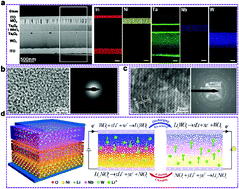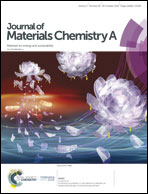An intelligent and portable power storage device able to visualize the energy status†
Abstract
Electrochromic power storage devices integrate energy storage and electrochromic behavior into a single full cell that can enable the visualization of the energy status by the naked eyes. One challenge for achieving practical applications is to develop intelligent and portable all-inorganic electrochromic power storage devices. Herein, ultrathin all-inorganic electrochromic power storage devices (EPSDs) comprising two complementary electrochromic anode and cathode electrodes were designed and constructed via the reactive magnetron sputtering method. The synergy between the two electrode materials enabled the EPSD to operate in the voltage range from −1.5 to 2.0 V, and inorganic electrolytes were introduced to ensure that the EPSD could stably work in a wide operating voltage window. The charge transfer and distribution in the electrode materials during the electrochemical process were comprehensively studied via theoretical simulations based on density functional theory calculations. Moreover, the EPSD could deliver a high energy density of 0.36 W h cm−3 and high power density of 71.6 W cm−3, as well as long-term lifespan of 5000 cycles with ∼96.4% capacity retention. This is superior to most other comparable electrochromic devices. More importantly, the energy status of the EPSD could be estimated in real time by the naked eyes according to the obvious color transition during the charge/discharge process. This work can provide a platform for developing smart and portable power storage devices with enhanced energy densities.



 Please wait while we load your content...
Please wait while we load your content...